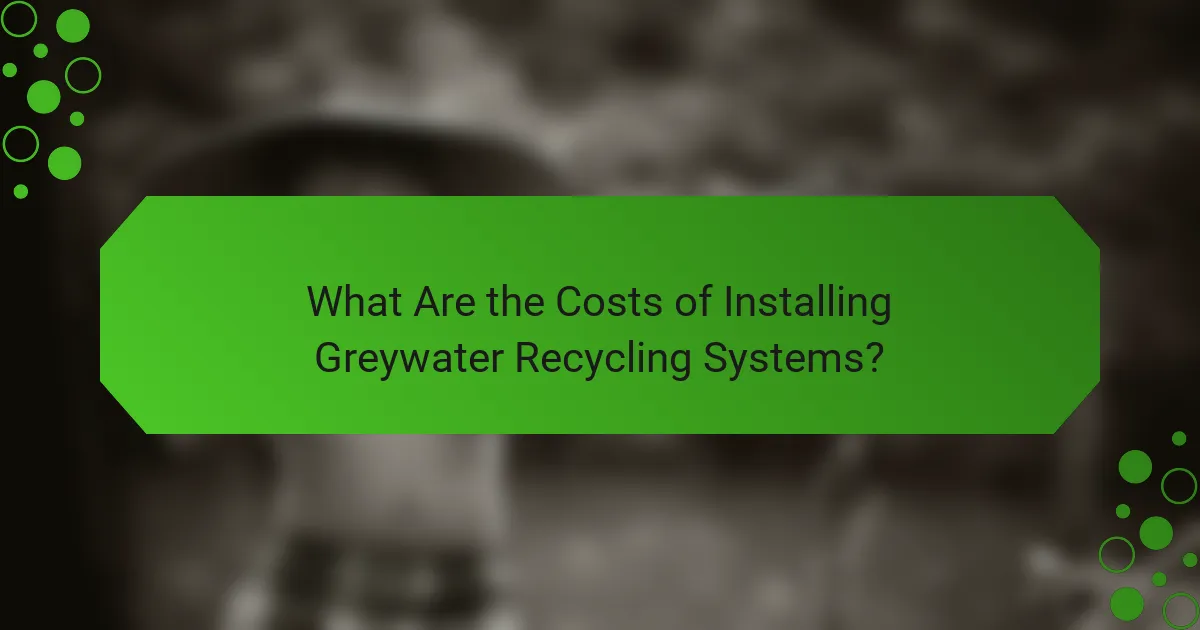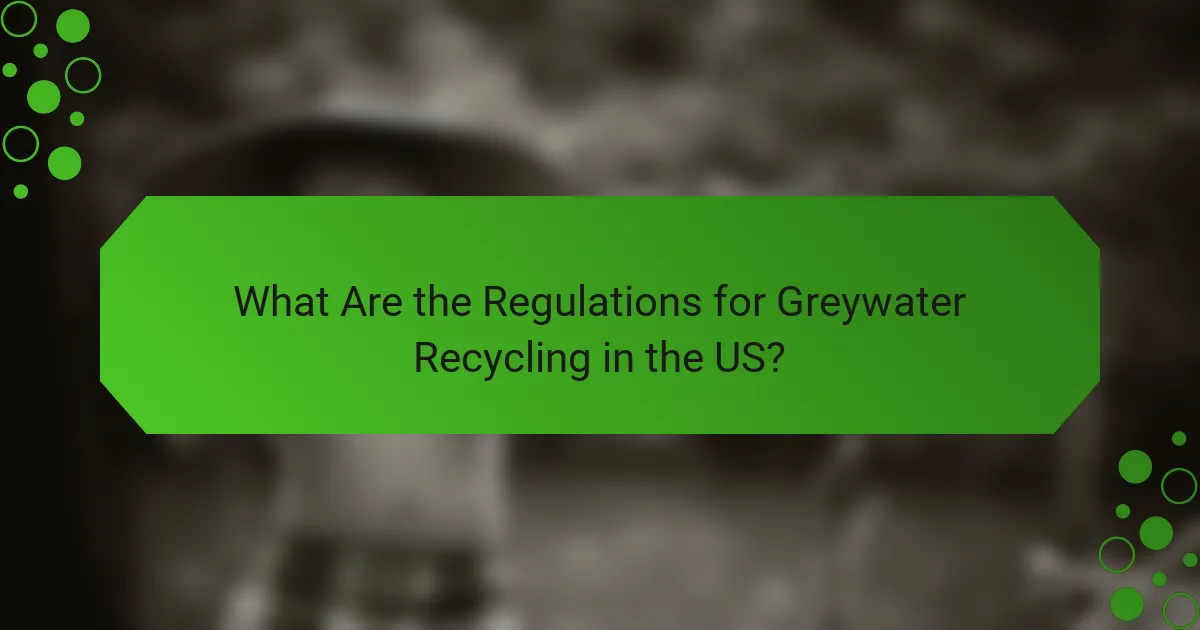Greywater recycling systems present a sustainable solution for water conservation by allowing the reuse of water from sinks, showers, and laundry. While the initial installation costs can vary based on system type and local regulations, the long-term benefits include reduced water consumption and lower utility bills. Understanding the specific regulations governing greywater use is essential for homeowners and businesses aiming to implement these systems effectively and legally.

What Are the Benefits of Greywater Recycling Systems?
Greywater recycling systems offer multiple advantages, including water conservation, cost savings, and positive environmental impacts. By reusing water from sinks, showers, and laundry, these systems can significantly reduce water consumption and lower utility bills.
Water conservation
Implementing greywater recycling systems can lead to substantial water conservation. Households can recycle approximately 50-80% of their wastewater, depending on usage patterns. This not only alleviates pressure on local water supplies but also helps communities facing water scarcity.
To maximize water conservation, consider installing systems that treat greywater for irrigation or toilet flushing. These applications can effectively reduce the demand for fresh water, especially in regions prone to drought.
Cost savings
Greywater recycling systems can result in significant cost savings on water bills. By reusing water for non-potable purposes, homeowners may see reductions in their monthly utility expenses. In many cases, the initial investment in a greywater system can be recouped within a few years through these savings.
Additionally, some regions offer incentives or rebates for installing greywater systems, further offsetting costs. It’s advisable to research local programs that may provide financial assistance or tax credits for such eco-friendly installations.
Environmental impact
The environmental benefits of greywater recycling systems are considerable. By reducing the amount of wastewater entering sewage systems, these systems help decrease the burden on treatment facilities and lower the risk of water pollution. This is particularly important in urban areas where infrastructure can be strained.
Moreover, using recycled greywater for irrigation can enhance soil health and reduce the need for chemical fertilizers. This practice promotes sustainable landscaping and supports local ecosystems, contributing to overall environmental well-being.
Increased property value
Installing a greywater recycling system can enhance property value by making a home more attractive to environmentally conscious buyers. As water scarcity becomes a growing concern, homes equipped with sustainable features like greywater systems may command higher prices in the real estate market.
Additionally, properties with lower utility costs can appeal to potential buyers looking for long-term savings. Investing in greywater recycling not only benefits the environment but also positions a property favorably in a competitive market.

What Are the Costs of Installing Greywater Recycling Systems?
The costs of installing greywater recycling systems can vary significantly based on system type, installation complexity, and local regulations. Homeowners should expect initial expenses, ongoing maintenance costs, and potential long-term savings when considering these systems.
Initial installation costs
Initial installation costs for greywater recycling systems typically range from a few hundred to several thousand USD. Factors influencing these costs include the system’s size, the complexity of plumbing modifications, and whether professional installation is required. Simple systems may be more affordable, while advanced setups with filtration and treatment can be pricier.
Homeowners should also consider any necessary permits or inspections, as local regulations may require compliance with specific standards, which can add to the overall expense.
Maintenance expenses
Maintenance expenses for greywater recycling systems are generally low but should not be overlooked. Regular upkeep may include cleaning filters, checking pumps, and ensuring the system operates efficiently. Annual maintenance costs can range from a few dozen to a few hundred USD, depending on the system’s complexity and usage.
It’s advisable to schedule routine inspections to prevent larger issues, which can lead to costly repairs and system downtime.
Long-term savings
Long-term savings from greywater recycling systems can be substantial, particularly in areas with high water costs. Homeowners may see reductions in their water bills by reusing greywater for irrigation or toilet flushing, potentially saving hundreds of USD annually. The payback period for these systems can vary, often ranging from 3 to 10 years.
Additionally, using greywater can contribute to environmental sustainability by reducing demand on municipal water supplies and minimizing wastewater generation, which can be a significant benefit for eco-conscious homeowners.

What Are the Regulations for Greywater Recycling in the US?
Greywater recycling regulations in the US vary significantly by state and locality, focusing on the safe reuse of wastewater from sinks, showers, and laundry. Understanding these regulations is crucial for homeowners and businesses looking to implement greywater systems legally and effectively.
State-specific regulations
Each state has its own set of regulations governing greywater recycling, which can include definitions of greywater, allowable uses, and system design requirements. For instance, California has comprehensive guidelines that promote greywater use for irrigation, while states like Florida have more restrictive measures. It’s essential to check local laws, as some municipalities may have additional rules that impact greywater systems.
Permitting requirements
In many states, obtaining a permit is a necessary step before installing a greywater system. The permitting process often involves submitting detailed plans that outline the system’s design and intended use. Homeowners should be prepared to provide information about water sources, storage methods, and how the system will prevent contamination.
Health and safety standards
Health and safety standards for greywater recycling systems are designed to protect public health and the environment. These standards typically require that greywater be treated to a certain level before reuse, especially for applications like irrigation. Homeowners should ensure their systems comply with these standards to avoid potential health risks and legal issues.

How Do Greywater Recycling Systems Work?
Greywater recycling systems collect and treat wastewater from sources like sinks, showers, and washing machines for reuse in non-potable applications. These systems help conserve water, reduce utility costs, and lessen the environmental impact of wastewater disposal.
Types of systems
There are primarily two types of greywater recycling systems: decentralized and centralized. Decentralized systems are installed at individual homes or buildings, while centralized systems serve multiple properties, often managed by municipalities or larger facilities.
Decentralized systems can be simpler and more cost-effective for single-family homes, whereas centralized systems may offer economies of scale for larger communities. Each type has its own installation and maintenance requirements that should be considered based on local regulations and available space.
Filtration processes
Filtration is a critical step in greywater recycling, ensuring that contaminants are removed before reuse. Common filtration methods include sediment filters, which remove larger particles, and activated carbon filters, which eliminate odors and chemicals.
Advanced systems may also incorporate biological treatment processes, such as constructed wetlands or biofilters, to further purify greywater. Selecting the right filtration process depends on the intended use of the recycled water and local health regulations.
Distribution methods
Distribution methods for recycled greywater vary based on the system design and intended applications. Common methods include subsurface irrigation for landscaping and direct plumbing connections for toilet flushing.
When implementing a distribution method, it is essential to comply with local codes and ensure that the system is designed to prevent cross-contamination with potable water supplies. Regular maintenance and monitoring are also crucial to ensure the system operates efficiently and safely.

What Are the Best Greywater Recycling Systems Available?
The best greywater recycling systems efficiently reclaim water from sinks, showers, and washing machines for reuse in irrigation or toilet flushing. Key factors to consider include system efficiency, installation costs, and compliance with local regulations.
Brand A system overview
Brand A offers a compact greywater recycling system designed for residential use. This system captures water from various household sources and filters it for safe reuse, making it ideal for eco-conscious homeowners.
Installation typically ranges from $1,500 to $3,000, depending on the complexity of the plumbing and local labor costs. Brand A systems are known for their user-friendly controls and low maintenance requirements.
Brand B system features
Brand B focuses on advanced filtration technology, ensuring high-quality greywater for non-potable applications. This system features a multi-stage filtration process that removes contaminants effectively, making it suitable for urban settings.
With an installation cost between $2,000 and $4,000, Brand B systems are slightly more expensive but offer enhanced performance. They also come with smart monitoring capabilities, allowing users to track water usage and system efficiency through a mobile app.
